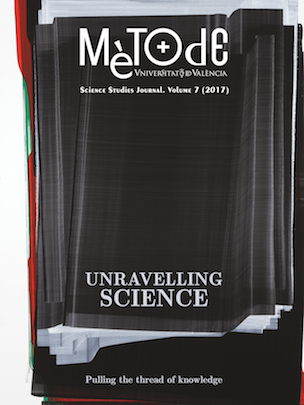Ghost particles in the universe: Neutrinos in astrophysics and cosmology
DOI:
https://doi.org/10.7203/metode.7.8507Palabras clave:
neutrinos, dark matter, supernova, flavor oscillations, astroparticle physics Resumen
Resumen
Neutrinos are nearly massless and very difficult to detect because they interact so very weakly. Sixty years after seeing the first of these «ghost particles» we know a lot about their properties. Today, observing them in nuclear reactors, the Sun, the Earth’s crust and atmosphere, and at high energies from distant cosmic sources is almost a routine task – they have become unique astrophysical messengers. They are important for a number of aspects: neutrinos shape some of the most dramatic astrophysical phenomena in the form of stellar-collapse supernova explosions, they may have created the excess of matter over antimatter in the universe, and neutrino-like «weakly interacting massive particles» may well account for the dark matter of the universe.
 Descargas
Descargas
 Citas
Citas
Bertone, G. (Ed.). (2010). Particle dark matter: Observations, models and searches. Cambridge: University Press.
Bilenky, S. (2010). Introduction to the physics of massive and mixed neutrinos. Lecture Notes in Physics, 817, 1–255. doi: 10.1007/978-3-642-14043-3
Buchmüller, W., Di Bari, P., & Plümacher, M. (2005). Leptogenesis for pedestrians. Annals of Physics, 315, 305–351. doi: 10.1016/j.aop.2004.02.003
Dell’Oro, S., Marcocci, S., Viel, M., & Vissani, F. (2016). Neutrinoless double beta decay: 2015 Review. Advances in High Energy Physics, 2162659. doi: 10.1155/2016/2162659
UNE Collaboration. (2015). Long-baseline neutrino facility (LBNF) and deep underground neutrino experiment (DUNE). Conceptual design report. Volume 2: The Physics Program for DUNE at LBNF. Retrieved from http://arXiv.org/abs/1512.06148
Gariazzo, S., Giunti, C., & Laveder, M. (2016). Neutrino unbound. Retrieved from http://www.nu.to.infn.it/
Horowitz, C. J., Coakley, K. J., & McKinsey, D. N. (2003). Supernova observation via neutrino-nucleus elastic scattering in the CLEAN detector. Physical Review D, 68, 023005. doi: 10.1103/PhysRevD.68.023005
Hyper-Kamiokande Proto-Collaboration. (2015). Physics potential of a long-baseline neutrino oscillation experiment using a J-PARC neutrino beam and Hyper-Kamiokande. Progress of Theoretical and Experimental Physics, 053C02. doi: 10.1093/ptep/ptv061
IceCube Collaboration. (2013). First observation of PeV-energy neutrinos with IceCube. Physical Review Letters, 111, 021103. doi: 10.1103/PhysRevLett.111.021103
Janka, H.-T. (2012). Explosion mechanisms of core-collapse supernovae. Annual Review of Nuclear and Particle Science, 62, 407–451. doi: 10.1146/annurev-nucl-102711-094901
JUNO Collaboration. (2016). Neutrino physics with JUNO. Journal of Physics G: Nuclear and Particle Physics, 43, 030401. doi: 10.1088/0954-3899/43/3/030401
Koshiba, M. (1992). Observational neutrino astrophysics. Physics Reports, 220, 229–381. doi: 10.1016/0370-1573(92)90083-C
Mirizzi, A., Tamborra, I., Janka, H.-T., Saviano, N., Scholberg, K., Bollig, R., … Chakraborty, S. (2016). Supernova neutrinos: Production, oscillations and detection. La Rivista del Nuovo Cimento, 39, 1–112. doi: 10.1393/ncr/i2016-10120-8
Scholberg, K. (2012). Supernova neutrino detection. Annual Review of Nuclear and Particle Science, 62, 81–103. doi: 10.1146/annurev-nucl-102711-095006
Villaescusa-Navarro, F., Bull, P., & Viel, M. (2015). Weighing neutrinos with cosmic neutral hydrogen. Astrophysical Journal, 814, 146–165. doi: 10.1088/0004-637X/814/2/146
Descargas
Publicado
Cómo citar
-
Resumen989
-
PDF 347
Número
Sección
Licencia
![]()
Todos los documentos incluidos en OJS son de acceso libre y propiedad de sus autores.
Los autores que publican en esta revista están de acuerdo con los siguientes términos:
- Los autores conservan los derechos de autor y garantizan a Metode Science Studies Journal el derecho a la primera publicación del trabajo, licenciado bajo una licencia de Creative Commons Reconocimiento-NoComercial-SinObraDerivada 4.0 Internacional, que permite a otros compartir el trabajo con un reconocimiento de la autoría del trabajo y citando la publicación inicial en esta revista.
- Se permite y se anima a los autores a difundir sus trabajos electrónicamente a través de páginas personales e institucionales (repositorios institucionales, páginas web personales o perfiles a redes profesionales o académicas) una vez publicado el trabajo.





